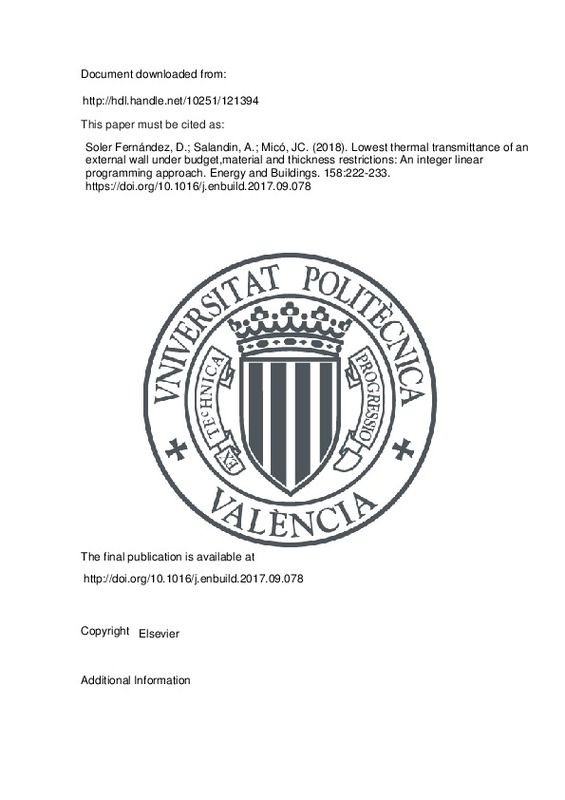JavaScript is disabled for your browser. Some features of this site may not work without it.
Buscar en RiuNet
Listar
Mi cuenta
Estadísticas
Ayuda RiuNet
Admin. UPV
Lowest thermal transmittance of an external wall under budget,material and thickness restrictions: An integer linear programming approach
Mostrar el registro sencillo del ítem
Ficheros en el ítem
| dc.contributor.author | Soler Fernández, David
|
es_ES |
| dc.contributor.author | Salandin, Andrea
|
es_ES |
| dc.contributor.author | Micó, Joan C.
|
es_ES |
| dc.date.accessioned | 2019-05-31T20:45:47Z | |
| dc.date.available | 2019-05-31T20:45:47Z | |
| dc.date.issued | 2018 | es_ES |
| dc.identifier.issn | 0378-7788 | es_ES |
| dc.identifier.uri | http://hdl.handle.net/10251/121394 | |
| dc.description.abstract | [EN] This paper deals with the minimization of a building¿s external wall thermal transmittance, with theaim of improving the energy efficiency of the building. The wall¿s thermal transmittance must abide bythe current legislation, but also suit the limitations of other construction parameters, mainly budget andthickness, but also time limit, workforce, number and thickness of the layers and availability of materialsdepending on the approach.The optimization is achieved formulating an Integer Linear Programming (ILP) problem involving theparameters mentioned above. Therefore, any available ILP solver can be run to obtain the best combinationof the different materials and thicknesses for the layers, in order to minimize the thermal transmittance.This paper presents a case study of a common but representative external wall consisting of 6 layers,with more than 670,000 possible combinations of materials and their thicknesses. The study concludeswith a comparison of the lowest thermal transmittance obtained for a selection of budget and thicknesscombinations for the mentioned wall. | es_ES |
| dc.description.sponsorship | This work was partially supported by the "Ministerio de Economia y Competitividad, Programa Estatal de Investigacion, Desarrollo e Innovacion 582 Orientada a los Retos de la Sociedad, Proyectos I+D+I 2014", Spain, under Grant TEC2014-52690-R. | es_ES |
| dc.language | Inglés | es_ES |
| dc.publisher | Elsevier | es_ES |
| dc.relation.ispartof | Energy and Buildings | es_ES |
| dc.rights | Reconocimiento - No comercial - Sin obra derivada (by-nc-nd) | es_ES |
| dc.subject | Thermal transmittance | es_ES |
| dc.subject | Building envelope | es_ES |
| dc.subject | External wall | es_ES |
| dc.subject | Integer linear programming | es_ES |
| dc.subject | Building process | es_ES |
| dc.subject | Bdget | es_ES |
| dc.subject.classification | MATEMATICA APLICADA | es_ES |
| dc.subject.classification | FISICA APLICADA | es_ES |
| dc.title | Lowest thermal transmittance of an external wall under budget,material and thickness restrictions: An integer linear programming approach | es_ES |
| dc.type | Artículo | es_ES |
| dc.identifier.doi | 10.1016/j.enbuild.2017.09.078 | es_ES |
| dc.relation.projectID | info:eu-repo/grantAgreement/MINECO//TEC2014-52690-R/ES/INTEGRACION DEL SMARTPHONE Y EL VEHICULO PARA CONECTAR CONDUCTORES, SENSORES Y ENTORNO A TRAVES DE UNA ARQUITECTURA DE SERVICIOS FUNCIONALES/ | es_ES |
| dc.rights.accessRights | Abierto | es_ES |
| dc.contributor.affiliation | Universitat Politècnica de València. Departamento de Matemática Aplicada - Departament de Matemàtica Aplicada | es_ES |
| dc.contributor.affiliation | Universitat Politècnica de València. Departamento de Física Aplicada - Departament de Física Aplicada | es_ES |
| dc.description.bibliographicCitation | Soler Fernández, D.; Salandin, A.; Micó, JC. (2018). Lowest thermal transmittance of an external wall under budget,material and thickness restrictions: An integer linear programming approach. Energy and Buildings. 158:222-233. https://doi.org/10.1016/j.enbuild.2017.09.078 | es_ES |
| dc.description.accrualMethod | S | es_ES |
| dc.relation.publisherversion | http://doi.org/10.1016/j.enbuild.2017.09.078 | es_ES |
| dc.description.upvformatpinicio | 222 | es_ES |
| dc.description.upvformatpfin | 233 | es_ES |
| dc.type.version | info:eu-repo/semantics/publishedVersion | es_ES |
| dc.description.volume | 158 | es_ES |
| dc.relation.pasarela | S\347133 | es_ES |
| dc.contributor.funder | Ministerio de Economía, Industria y Competitividad | es_ES |







![[Cerrado]](/themes/UPV/images/candado.png)

